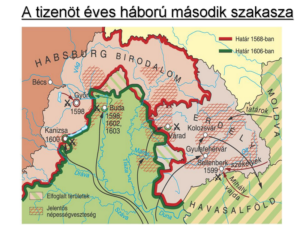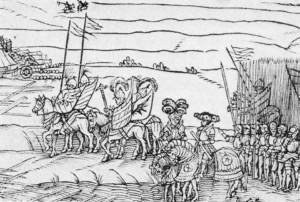The Long War, Part 39 / Conclusion

The 15-Year-War (or 13-year-long-war) was not exclusively fought in Hungary but there were other lands that were involved. Although most of the struggles took place in Royal Hungary or in Transylvania and in the Ottoman Occupied Lands of Hungary, the soldiers who had come to fight there were equally from West Europe, Africa, and Asia.

In the army of the Ottoman Empire, there were the sons of many nations from Egypt, Syria, the Middle East, Mesopotamia, Arabia, the Balkans, the Crimean Khanate, and the Wallachian Voivodes while the Habsburg Empire had many Hungarian, German, Czech, Walloon, French, Italian, Spanish soldiers. Not to forget the soldiers of the Transylvanian Principality, the Hungarian, Wallachian, and Székely Hungarian people. We have to take into account the various volunteers and mercenaries, adventurers, and all the Polish, Cossack, or British and Scottish soldiers from the four corners of the Earth.
It was for the first time since the age of the Hungarian-Ottoman castle-war period that the two superpowers of the world faced each other in a properly proclaimed war but finally, none of them could win over the other. The Ottoman war machine had been working well, the Sultan always had a disciplined and steady standing army at his disposal, waiting for the single order of the ruler to set out.
The logistics were well-organized, the artillery was up to the latest standards of the period, and the elite footmen, and the fanatic Janissaries’ army also proved to be effective. It was not true as far as the Ispahi cavalry was concerned, though. They have been often scattered in the first serious clashes. The combat value of the marauders was very low, the Asabs, the Akindjies, Gurebas, etc. were not regarded as serious forces.

The Christian army was still based on mercenaries and the soldiers of the noble Estates. While the mercenaries were extremely expensive, the soldiers of the Estates depended on the local noblemen. The soldiers were hired year by year and they couldn’t get used to each other which proved to be a disadvantage in the battle. As the recruitment began only after the country had been attacked, it was always a very slow process. The colonel appointed for conducting the recruitment went to his district to find the soldiers who often had to bring their own weapons into the army or the colonel took the price of their equipment off their pay.

The Holy Roman Empire was huge and it took weeks for the troops to arrive at the battlefields of Hungary. Truly, these problems have burdened the Turks as well, and that was why the clashes happened mostly at the end of the summer or during the autumn. The time limit minimalized the annual success in general.

The majority of the soldiers were the pike-and-shot troops in the Christian army which was the most up-to-date fighting style of the age. Besides, the cavalry was more and more supplied with firearms. (My remark: while Hungarian Hussars were equipped with pistols in 1572, the Ottoman Sipahies absolutely denied using firearms for many decades to come.)
The quality of the Christians’ artillery had also been updated to the Ottomans’ level but as for logistics, they have been lagging for many years. Their army was not a standing army and it had to be reorganized every year which resulted in serious losses in time and money.

The two sides’ military abilities for conducting an action were quite balanced and it meant that none of them could achieve their strategic goals. The Habsburg forces could not even take Buda Castle after three sieges and on top of that, they were unable to keep the more important forts around it (Fehérvár, Hatvan, Esztergom). Above all, they have lost two important Borderland castles, Eger and Kanizsa. Here is more about Eger Castle:
https://www.hungarianottomanwars.com/ottoman-occupied-lands/eger/
On the other hand, the Turks were not able to break through the line of the Hungarian chain of Borderland castles, either. Having taken Győr and Pápa castles only for a short time, they were forced to defend and give up several of their conquests.

Both empires were forced to fight a two-fronted war for a longer or for a shorter time. In the beginning, the Ottoman Empire faced only the Habsburg Empire and the Kingdom of Hungary but soon, the Transylvanian Principality and the two Wallachian Principalities joined in against them. After the turn of the century, an internal war tore Transylvania off this conflict and when Prince Bocskai came into power, it fully became the Sultan’s ally. Then, it was the Habsburgs who had to open a second front of the war, fighting against the Hungarian rebels and the Turks at the same time. As we could see, there was tremendous pressure on them and the Habsburgs lost not just Lower- and Upper Hungary but the Castle of Esztergom as well.

The constant destruction of the various armies has had a very serious effect on the population and the settlement structure of the country, too. According to recent studies, Hungary’s ethnic character has been profoundly changed not because of the campaign of Sultan Suleiman I but rather as a result of the 15-Year War. Entire lines of settlements have disappeared from the map where the Imperial mercenaries and the Ottoman troops had been marching through. Starvation and epidemics were coming in their wake.

The Habsburg Court ran out of money and wanted to refill the Treasury by suing wealthy Hungarian noblemen under pretenses. These fabricated cases have caused new ethnic and religious cracks between the Hungarian / Croatian Estates and the Habsburgs. The commoners were getting transformed into the military as we can see how the herders of grey cattle became crowds of armed and seasoned Hajdú soldiers. The noblemen were settling them on their blackened and depopulated lands, giving them freedoms who provided military and/or peasant services.

Finally, the Hungarian Estates realized that they would have to get prepared for a longer coexistence with the Turks.
Nagy László, a famous and acknowledged historian of this age remarked that this war was creating a dividing crack regarding the idea of valor in the Hungarian Borderland warriors’ minds. It was as if these warriors had been losing their interest in conducting heroic deeds, raids, duels, and ambushes.

By all means, the 15-Year War has resulted in a stalemate situation. To defeat the Ottoman Empire, the Christians should have reformed their army, changing their mercenary-based system into large-scale armies. Bigger capacity artillery was to be established and the officers needed to be more educated. Also, they needed greater discipline among the soldiers and better organized logistics. Of course, a more centralized governmental structure was the basic thing to create the financial environment for keeping a standing army. The Habsburg Empire was able to fulfill these requirements only towards the end of the 17th century, though. In the picture below, you can see the Status Quo after the Long War.

Source: Szibler Gábor
Dear Readers, I can only make this content available through small donations or by selling my books or T-shirts.
If you like my writings, please feel free to support me with a coffee here:
You can check out my books on Amazon or Draft2Digital, they are available in hardcover, paperback, or ebook:
https://www.amazon.com/dp/198020490X
or at https://books2read.com/b/boYd81


My work can also be followed and supported on Patreon: Become a Patron!http://Become a Patron!



